70% Have Experienced Bad Restroom Conditions It’s back to school time and this year a survey got the deets about teens’ handwashing habits, restroom evaluations and whether or not they stay home from school when they’re sick. The Healthy Handwashing Survey™, conducted by Bradley Company, connected with 1,012 high schoolers ages 14 to 18 to gather their insights and Read more
Healthy Handwashing Survey
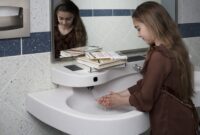
70% Have Experienced Bad Restroom Conditions
It’s back to school time and this year a survey got the deets about teens’ handwashing habits, restroom evaluations and whether or not they stay home from school when they’re sick. The Healthy Handwashing Survey™, conducted by Bradley Company, connected with 1,012 high schoolers ages 14 to 18 to gather their insights and opinions.
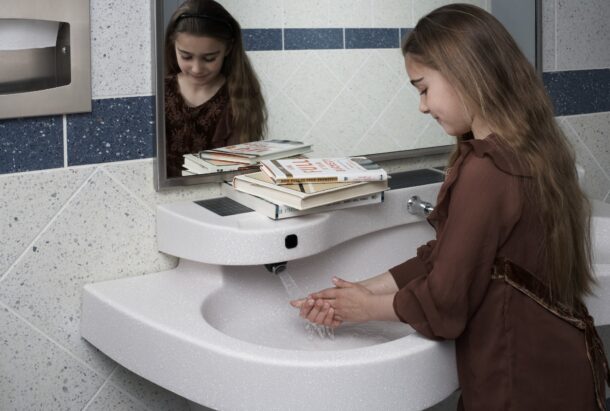
Handwashing & Health
First, the survey found teens are educated about the benefits of handwashing since 97% believe sudsing up with soap and water is an important action for maintaining their overall health. Despite that, nearly two-thirds admit on occasion they’ve cheated by skipping the soap and simply rinsing with water. In addition, one-third say they frequently see others leave the school restroom without washing up at all.
When it comes to removing the most germs from their hands, students have also learned that handwashing with soap aces hand sanitizer. 72% correctly believe their hands are less germy when they lather up with soap and water than after using sanitizer.
In general, students are conscientious about staying healthy. 74% take steps to avoid a sick classmate by eliminating physical contact and staying away from them. In the bathroom, students circumnavigate germs by operating the toilet flusher with their foot and using a paper towel to mitigate contact with doorknobs and faucets.
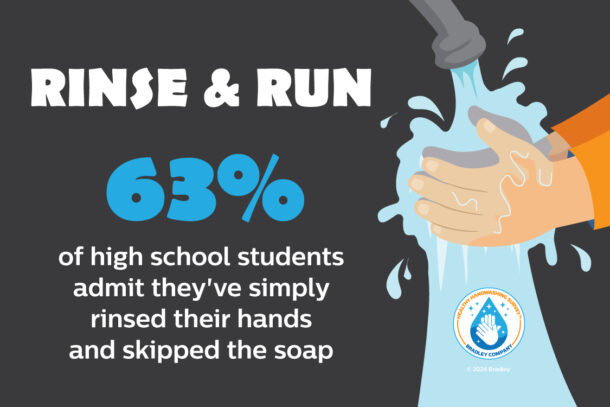
Restroom Complaints
Unfortunately, the survey revealed that most students use their school restrooms sparingly. 64% say they visit the facilities just once or twice a day. When asked why they avoid the facility, about 40% cited the fact that it’s usually dirty or smells bad.
70% report they’ve actually had a particularly unpleasant experience due to the condition of the facilities. Besides unpleasant smells, too many people in the restroom, clogged/unflushed toilets and stall doors that don’t latch closed cause the most negative feelings about school restrooms.
When they encounter a bad bathroom situation, 57% simply leave without using the restroom and nearly half say they steer clear of using that restroom in the future.
Teens also take issue with their peers’ negligence in restrooms. They’re particularly bothered by reckless behavior that causes damage to the facility (57%) and used paper towels left on the floor or in the sink area (53%) that makes the space look unkempt.
Overall, 48% of high schoolers say their school restrooms are average, which equates to a C grade, and 26% feel the conditions are poor, meaning the facilities got a D.
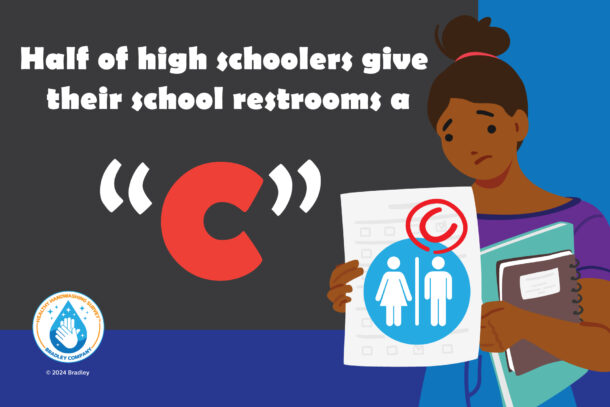
Restroom Recos
When asked how their school bathrooms could be improved, 56% responded that they would like them to be cleaner and stocked more frequently. More privacy with taller doors and no gaps between panels is another top request, along with more deodorizing or air freshener.
“Unfortunately, poor restroom conditions lead teens to think less of their school and cause them to believe it’s poorly run,” said Jon Dommisse, vice president of marketing and corporate communication for Bradley. “Our research shows that restroom conditions speak volumes about public establishments, including schools, so restroom cleanliness and maintenance is a must.”
Even when they are away from school, teens use restrooms as a barometer. Two-thirds say they have made a conscious decision to choose a business, such as a restaurant, store or gas station, because they know it has well-maintained restrooms.
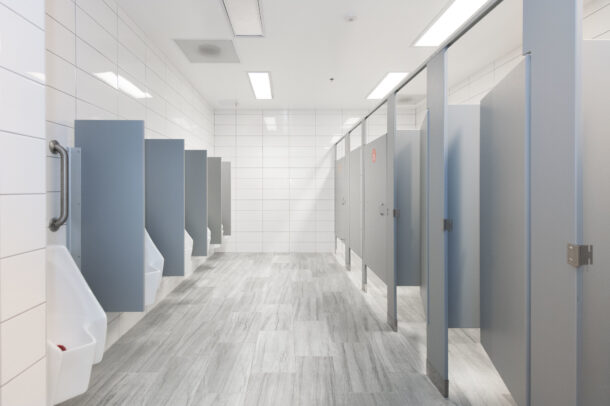
Sickness Drives School Misses
While it’s an age-old joke, the survey found that the majority of teenagers do miss school when they’re sick. Three out of four say they stay home when they’re ill and the call is typically theirs to make – as opposed to their parents. However, for one out of five, the decision is influenced by whether or not they have tests to take or projects to complete.
The annual Healthy Handwashing Survey from Bradley queried 1,012 high school students Jan. 4-17, 2024, about their handwashing habits, school restrooms and germ avoidance. Teens were from around the country and were fairly evenly split between male and female.
For more information, visit www.bradleycorp.com/handwashing.
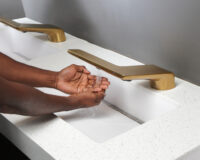
Each year on October 15, Global Handwashing Day highlights how consistently washing hands with soap and water is an effective and affordable way to prevent viruses and diseases, and ultimately save lives. This year’s theme, “Clean hands are in reach,” accentuates the important link between good handwashing practices and disease prevention. According to the Global Handwashing Partnership, creators Read more
Each year on October 15, Global Handwashing Day highlights how consistently washing hands with soap and water is an effective and affordable way to prevent viruses and diseases, and ultimately save lives.
This year’s theme, “Clean hands are in reach,” accentuates the important link between good handwashing practices and disease prevention.
According to the Global Handwashing Partnership, creators of Global Handwashing Day, great strides have been made in hygiene commitment and action in the past few years, but globally, better access and more practice is needed to achieve hand hygiene for all.
Less than a fifth of people worldwide currently wash their hands at critical times. Even in areas where handwashing is an established practice – and soap and water are accessible – people still fail to wash their hands often enough.
As for school-aged children, more than a million children globally die each year due to diarrhea but handwashing with soap could prevent two-thirds of those deaths. Further, children lose 443 million school days each year because of water-related illnesses. Without handwashing facilities in schools, children are more susceptible to illness, and less able to learn, grow and thrive.
Medical experts from the Centers for Disease Control and Prevention and the World Health Organization agree that developing a habit of consistent and thorough handwashing with soap and water is the best prevention of cold and flu germs and the spread of other contagious illnesses seen around the globe like diarrhea and pneumonia.
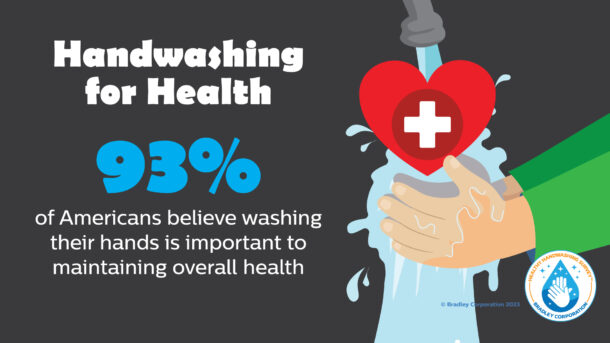
Survey Reveals Handwashing “Disconnects” in America
With a similar goal of stressing the health importance of regular handwashing, Bradley Corporation, an international manufacturer of commercial restroom fixtures, has conducted its annual Healthy Handwashing Survey. For 14 years the survey has highlighted Americans’ self-reported handwashing beliefs and behaviors, sometimes revealing disconnects in handwashing follow-through.
For example, the 2023 survey revealed that 93% of adults believe handwashing is essential to maintaining their overall health and 75% wash their hands more diligently during flu and virus outbreaks. However, Americans’ handwashing activity has dropped 30% over the past three years returning to pre-Covid levels. There has also been an increase in people taking handwashing shortcuts. 45% admit to just rinsing with water and skipping soap.
“The aim of our survey is to keep the health benefits of handwashing with soap top-of-mind, especially as we head into cold and flu season. Celebrating Global Handwashing Day is a natural outgrowth of that mission,” said Jon Dommisse, vice president of marketing and strategy for Bradley Corporation. “Connecting handwashing with our daily habits or rituals is an effective way to form good handwashing practices.”
Medical experts emphasize it’s important to wash your hands whenever the risk of spreading germs is high. For example, before and after eating or handling food, caring for someone who is sick, or after using the restroom, sneezing, coughing or blowing your nose.
“In addition to advocating for better handwashing practices, Global Handwashing Day is a great reminder for businesses and facilities to provide clean, well-stocked and maintained restrooms that support handwashing,” Dommisse said.
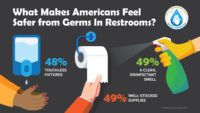
Most Americans seek out – and spend more – at businesses with good bathrooms while canceling businesses with messy ones Businesses that fail to keep their restrooms clean and maintained are unwittingly flushing away customers’ repeat business and sales. According to the Healthy Handwashing Survey™ from Bradley Corporation, almost 60% of Americans make it a point to Read more
Most Americans seek out – and spend more – at businesses with good bathrooms while canceling businesses with messy ones
Businesses that fail to keep their restrooms clean and maintained are unwittingly flushing away customers’ repeat business and sales. According to the Healthy Handwashing Survey™ from Bradley Corporation, almost 60% of Americans make it a point to stop at a business and will spend more money at the establishment if they know it has clean and maintained restrooms.

In fact, those age 25-44 are even more likely to shell out more cash based on the condition of a business’ restroom.
Conversely, there are negative business repercussions for experiencing a restroom in poor condition. More than half of Americans say an unclean or unpleasant public bathroom shows poor management and causes them to lower their opinion of the overall establishment. The 55+ age group is especially turned off by unkempt restrooms with more than 60% reporting a damaged impression of the overall business.
Almost 20% say a sloppy restroom actually makes them less likely to clean up after themselves.
The business fallout of unpleasant restrooms
Perhaps most damaging for customer-facing businesses is that 52% say a bad restroom experience causes them to vow not to return in the future or think twice about doing so. Another 32% will either tell a friend or post a comment on social media about the negative encounter.
While there are a variety of restroom maintenance issues that may tarnish customers’ restroom experiences, the most common ones include clogged or unflushed toilets; an overall appearance that is old, dirty or unkempt; unpleasant smells; and empty or jammed dispensers for soap, toilet paper and hand towels.
“Restroom maintenance may seem like a business no brainer but limited budgets and facility staffing issues mean that companies are doing more with less staff and resources,” says Jon Dommisse, vice president of marketing and corporate communication, Bradley Corporation. “Nevertheless, customers place a high value on clean restrooms – and reward businesses that offer them. It’s incumbent upon facility managers to prioritize regular restroom cleaning and make sure that everything is in good working order.”

Understanding the aversion to touching restroom surfaces
“In 2023, Americans continue to be in an elevated state of germ consciousness and don’t like touching things in shared public restroom spaces,” adds Dommisse. “As a result, people use all sorts of techniques to avoid coming into contact with surfaces.”
62% use a paper towel to avoid touching toilet flushers and faucet and door handles. 43% operate the flusher with their foot. 31% hover over the toilet seat and 27% open and close doors with their behind to eliminate contact. Women are considerably more likely than men to use these evasive actions.
With so many people deliberately avoiding contact with restroom surfaces, it’s not surprising that 82% believe it is important to have touchless fixtures in a public restroom. Another 60% are more likely to return to a business that offers touch-free technology like faucets, flushers, soap and towel dispensers in its restrooms.
“When asked what restroom improvements they’d like to see, cleanliness topped the list,” Dommisse said. “After that, Americans want touchless fixtures and better stocking of supplies, such as toilet paper, soap and paper towels.”

The annual Healthy Handwashing Survey from Bradley Corp. queried 1,025 American adults Jan. 4-10, 2023, about their handwashing habits, concerns about the coronavirus and flu and their use of public restrooms. Participants were from around the country and were fairly evenly split between men (45%) and women (55%).
For more information, visit www.bradleycorp.com/handwashing.
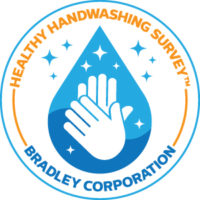
When it comes to restroom breaks, office workers in the U.S. say that touchless restroom fixtures are the number one feature that would make them feel safer when using their workplace restroom. According to the Healthy Handwashing Survey™ by Bradley Corp., touch-free washroom fixtures received the highest safety ranking, followed by access to well-stocked supplies such as soap Read more
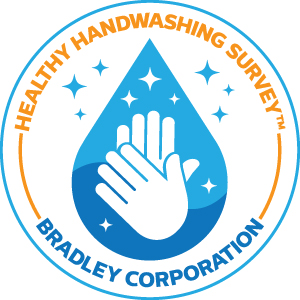 When it comes to restroom breaks, office workers in the U.S. say that touchless restroom fixtures are the number one feature that would make them feel safer when using their workplace restroom. According to the Healthy Handwashing Survey™ by Bradley Corp., touch-free washroom fixtures received the highest safety ranking, followed by access to well-stocked supplies such as soap and paper towels; a clean, disinfectant smell; sufficient space for social distancing; and posted signage with the restroom’s cleaning schedule.
When it comes to restroom breaks, office workers in the U.S. say that touchless restroom fixtures are the number one feature that would make them feel safer when using their workplace restroom. According to the Healthy Handwashing Survey™ by Bradley Corp., touch-free washroom fixtures received the highest safety ranking, followed by access to well-stocked supplies such as soap and paper towels; a clean, disinfectant smell; sufficient space for social distancing; and posted signage with the restroom’s cleaning schedule.
Not only do they associate touchless fixtures with a safer restroom environment, office workers view them as must haves. Nearly four-in-five (79%) of office workers believe no-touch fixtures are an important feature in workplace restrooms. Among the general U.S. population, this sentiment is even higher – 84% say they are important in public restrooms.
“Interestingly, two-thirds of office workers use a paper towel to avoid touching restroom door handles, flushers and faucet handles,” said Jon Dommisse, vice president of marketing and corporate communications, Bradley Corp. “This evasive action further demonstrates why touch-free restroom fixtures resonate so much with restroom users.”
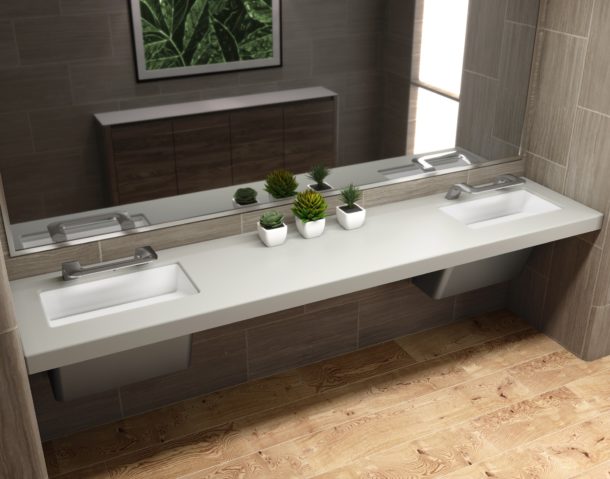
Handwashing is also top-of-mind for office workers, as 70% report washing their hands more now because of new Covid strains, such as the Delta variant. Overall, half of office workers are washing their hands six-plus times a day.
“Just as 9-11 changed air travel and the iPod changed how we listen to music, Covid has changed how we view handwashing and washrooms,” Dommisse said.
Rating the condition of workplace restrooms
The survey also shows 75% of office workers believe the condition of a workplace restroom is one indicator of how a company values its workforce. Fortunately, 68% of office workers rate their restrooms as excellent or very good.
That’s not to say office workers don’t experience problems with workplace restrooms. 81% have encountered at least one issue while using them. The most annoying issues – cited by 62% of workers – are empty or non-working soap, paper towel and/or toilet paper dispensers. Another 62% are concerned with restroom cleanliness.
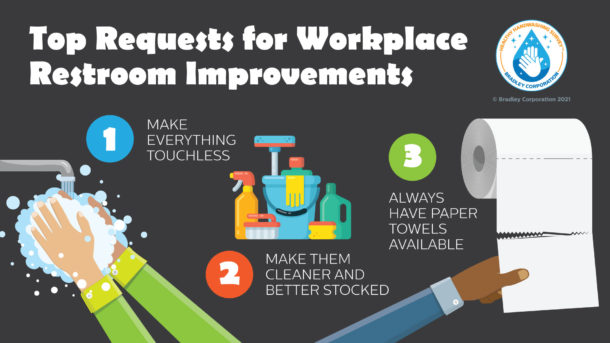
Highlighting office hygiene improvements
Most employers (62%) have made improvements to make employees feel safer returning to work amidst the pandemic with upgrades such as adding hand sanitizing stations around the office (66%), cleaning offices and restrooms more frequently (65%) and encouraging employees to stay home while they’re sick (51%).
Interestingly, only 42% of companies have communicated these changes to their employees.
Sharing these improvements positively impacts employers since 53% of office workers say their employer’s response to the pandemic makes them feel more valued, 50% say it shows the company cares about its employees, and 35% say it makes them feel more positive about their company.
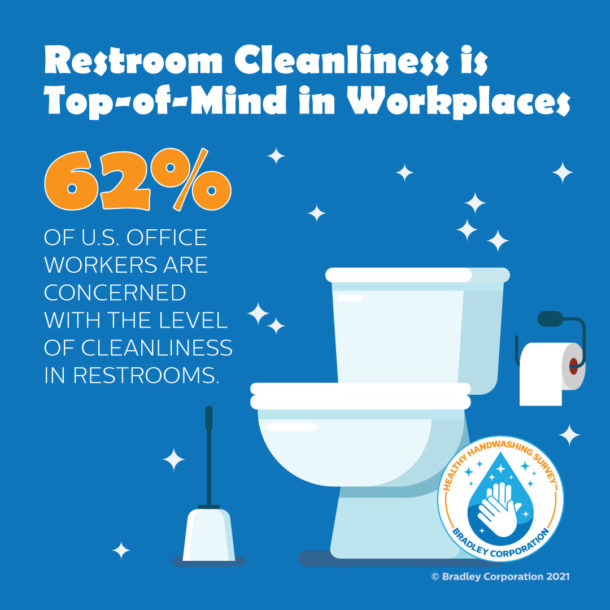
The Healthy Handwashing Survey from restroom equipment manufacturer, Bradley Corp., queried 1,035 American adults Aug. 3-10, 2021, about their handwashing habits, concerns about the coronavirus and their return to the workplace. A subset of 513 respondents who work in offices were identified and asked a series of applicable questions. Participants were from around the country and were evenly split between men and women. The Healthy Handwashing Survey of the general population has a margin of error of +/- 3% and the office worker subset has a margin of error of +/- 4%, with a 95% confidence level.
For more information, visit bradleycorp.com/handwashing.
